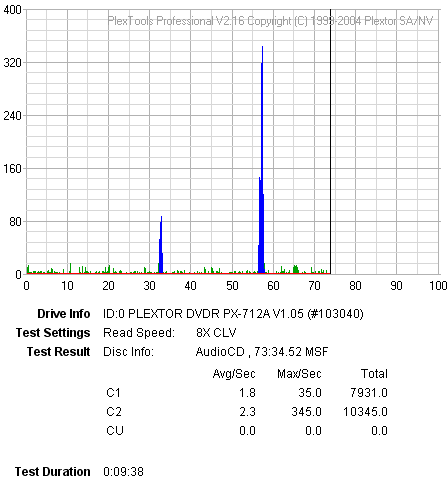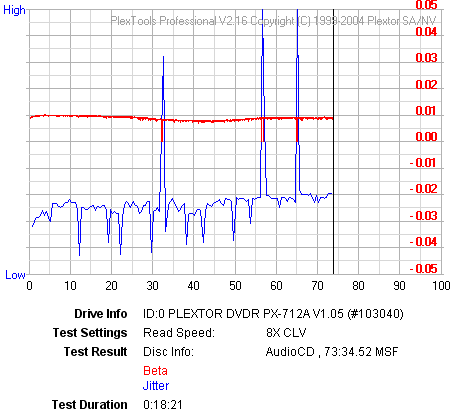1. Introduction
Ultradisc CD-R gold media -
Page 1
TECH SPECIFICATIONS: MFSL 24 KT Gold ULTRADISC CD-R
Anyone who has ever damaged a CD-R through abrasion or excessive exposure to
heat or light knows that CD-Rs are an imperfect technology and it's all too
facile and common to lose priceless data. For occasions when you can't
afford to endanger your data, Mobile Fidelity Sound Lab is proud to introduce
the Ultradisc CD-R. Our 24KT Gold ULTRADISC CD-R is designed for professional,
data critical, music and graphic archival applications, and all other data
storage where there is no margin for loss or error. These specially-gold-plated
ULTRADISC CD-Rs ensure excellent reflectivity, are non corrosive, and have
dramatically enhanced resistance to light and heat. Additional features include
instantaneous pit burning (burst burning) for superior pit formation and extremely
low to no error rate; and an added, patented, scratch resistant, protective
surface. Due to these features, little if any error correction is required
upon retrieval of information, producing precise reproduction of stored data.Where
as the average CD-R has a projected life span of only 20 years - if stored in
ideal conditions, our accelerated aging tests predict that the 24KT Gold ULTRADISC
CD-R will retain its specifications for more than 300 years. Meaning that,
now, information can be accurately stored and retrieved longer than ever before.
24 KT Gold Layer
Mobile Fidelity Sound Lab created the world's first 24 Karat Gold music CD in 1987: The ULTRADISC. Now MFSL has put that expertise in the development of the 24KT Gold ULTRADISC CD-R. The combination of the superior reflectivity and longevity of 99.99% pure 24 Karat Gold, in addition to a specialized, patented bonding agent, ensures that the ULTRADISC CD-R will never oxidize and fail to output information, as many commercially available CD-Rs do. The ULTRADISC CD-R is extremely stable in the real world environment.
Proprietary Photosensitive Dye
Unlike commonly used CD-Rs containing Cyanine (blue/green dye) or Metal Azo (deep blue dye), which lose their characteristics quickly from exposure to light and heat, the 24KT Gold ULTRADISC CD-R utilizes a patented photosensitive dye which ensures accurate burning and stability, plus exceptional longevity and durability. Whereas the two other types of dye are formed with linear molecular structures, which break down easily when exposed to the elements, the unique photosensitive dye utilized in the ULTRADISC CD-R has an annular structure which forms a strong and extremely stable chemical bond. On top of this, MFSL has added a patented, reinforcing coating for extra protection from scratching.

Extremely Accurate and Precise Burning
Mobile Fidelity Sound Lab has chosen to offer only slower speed (1-12X) CD-Rs.
Although the current trend is "faster is better", MFSL engineers
strongly disagree and urge audio professionals, archivists, audiophiles,
and discriminating collectors alike to burn their data in real time, better
known as 1X. Through a careful battery of tests conducted at Mobile Fidelity
Sound Lab, we have observed that real-time burning has always yielded superior
results. Higher burning rates cause errors and do not allow for proper pit
formation. Furthermore, higher speeds cause vibration in the drive when burning
the disc, thereby increasing jitter. In order to attain even higher burning
accuracy and overall quality, a specially formulated dye was created for
these slow-burn, precision ULTRADISC CD-Rs.

Accurate and Precise Information Retrieval
The ULTRADISC CD-R's specialized dye reacts more quickly to the writing laser than do other dyes. It reacts in a "burst" mode instead of the sluggish "melt" mode. Due to this instantaneous reaction, precise pit edges are formed. This is crucial for the laser pickup to accurately interpret the information, and thereby reducing or eliminating the use of interpolation/error correction circuitry. Additionally, a specially formulated, black ink is used to coat one side of the disc in order to reduce stray reflections which could alter readings.

Ultra Quality Control - 4 Levels of QC
Utilizing the highest quality control standards in the industry, all the manufacturing
and packaging of the ULTRADISC CD-R is done in state-of-the-art cleanroom
conditions. Mobile Fidelity Sound Lab has rejected random sampling techniques,
which are simply not stringent enough for critical data storage applications.
Instead, MFSL utilizes an unprecedented 4-level quality control process.
First, a sample out of every 3,000 discs is tested, critically examined and
evaluated for over 2 hours until given the approval for MFSL specifications.
Second, every single ULTRADISC CD-R is tested as it comes off the replication
line. High tech, extremely sophisticated computer analysis is used to test
jitter, thickness tolerances, gold uniformity and disc eccentricity. Third,
an inspector (wearing medical gloves) picks up and visually examines the
ULTRADISC CD-Rs for pinholes, gold consistency, oyster shelling, or any other
anomalies. Fourth, another inspector repeats this very time-consuming, manual/visual
examination just before the specialized, stray-reflection-reducing black
coating is applied. ULTRADISC CD-Rs have to pass all levels of QC before
they can be shipped. If a disc does not pass Mobile Fidelity Sound Lab's
elevated specifications, it will not be accepted as an ULTRADISC CD-R. This
is MFSL's guarantee to the user that every ULTRADISC CD-R is the finest engineered
recordable CD media available in the world.

In the following picture you can see the way the media is seated very convenient
for safe handling and better protection of the media.
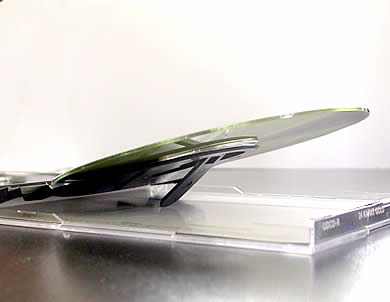
In this short review, we will try a simple experiment, simply out of
curiosity, in order to check the reliability of the writing quality
of the media and to see how
it reacts when kept in an office draw or left out
under the sun and rain. It should be interesting, don't you think?
2. The First Tests
Ultradisc CD-R gold media - Page 2
The First Tests
- Safe Operating Environment Sample
The first sample which we burned was stored within the operating environment for such media. According to ECMA, the storage environment for a CD should be:
| Temperature |
-20 °C to 50 °C |
| Relative Humidity |
5 % to 90 % |
| Wet Bulb Temperature |
29 °C max. |
| Atmospheric Pressure |
75 kPa to 105 kPa |
The measurements with Plextools v2.16 are the following:
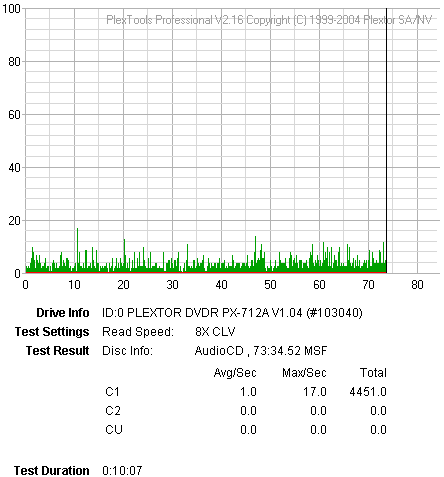
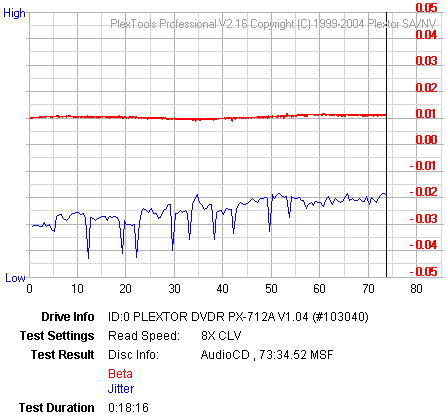
- Harsh Environment Sample
This sample, in contrast with the previous, was exposed to open weather conditions, hot sun, rain, moisture etc. Since there is no way to control the weather, the conditions imposed on the disc are totally random as opposed to a controlled test environment in a laboratory for example. The initial measurements for the specific disc are as follows:
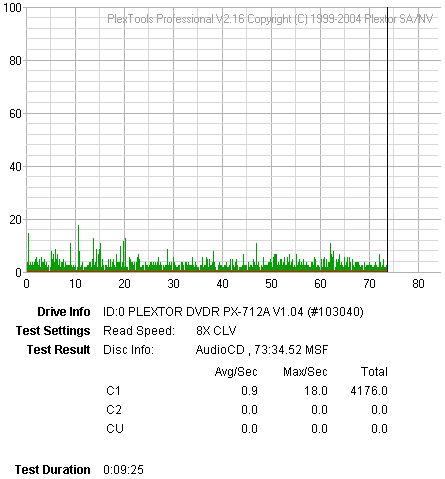
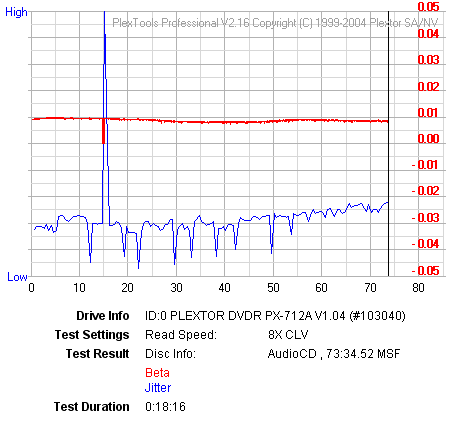
3. After a week
Ultradisc CD-R gold media - Page 3
After a week
We then kept the media under their respective environments for a further week and repeated the measurements.
- Safe Operating Environment Sample
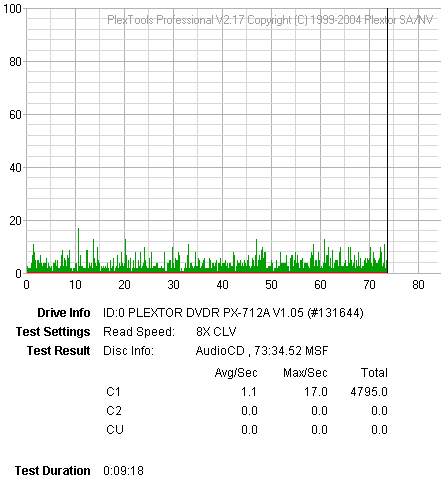
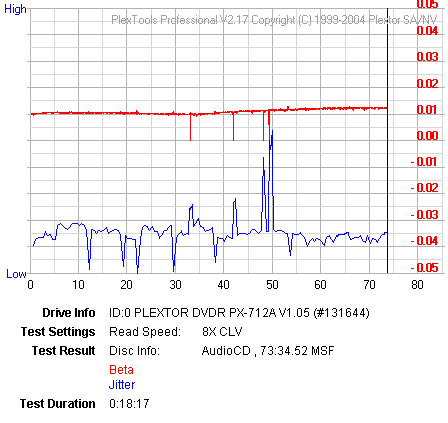
- Harsh Environment Sample
The weather conditions during the testing process are as follows: the tests began in August where the outside temperature was around 38 °C in the shade during noon (and hence much hotter under full sun where our test sample had been placed), while the temperature dropped to 34 °C in the evening. For a couple of days humidity was high and you could feel the moisture in the atmosphere. However, there was no rain.

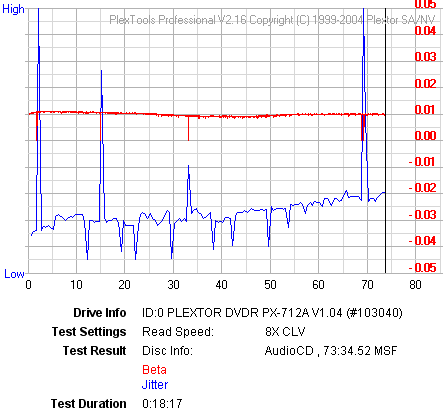
4. After three months
Ultradisc CD-R gold media - Page 4
After three months
After a further period of three months, we repeated the measurements for one more time.
- Safe Operating Environment Sample

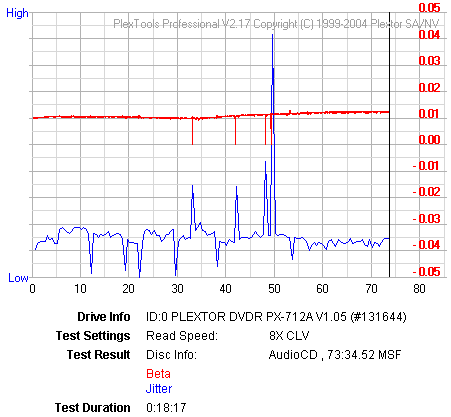
- Harsh Environment Sample
As you can imagine, over such a long period, we had just about all the changes in weather conditions, ok it didn't snow :-). We had the transition from summer to autumn and there were many rainy days, storms, heatwaves, etc. The humidity, especially during the night, was quite high.
